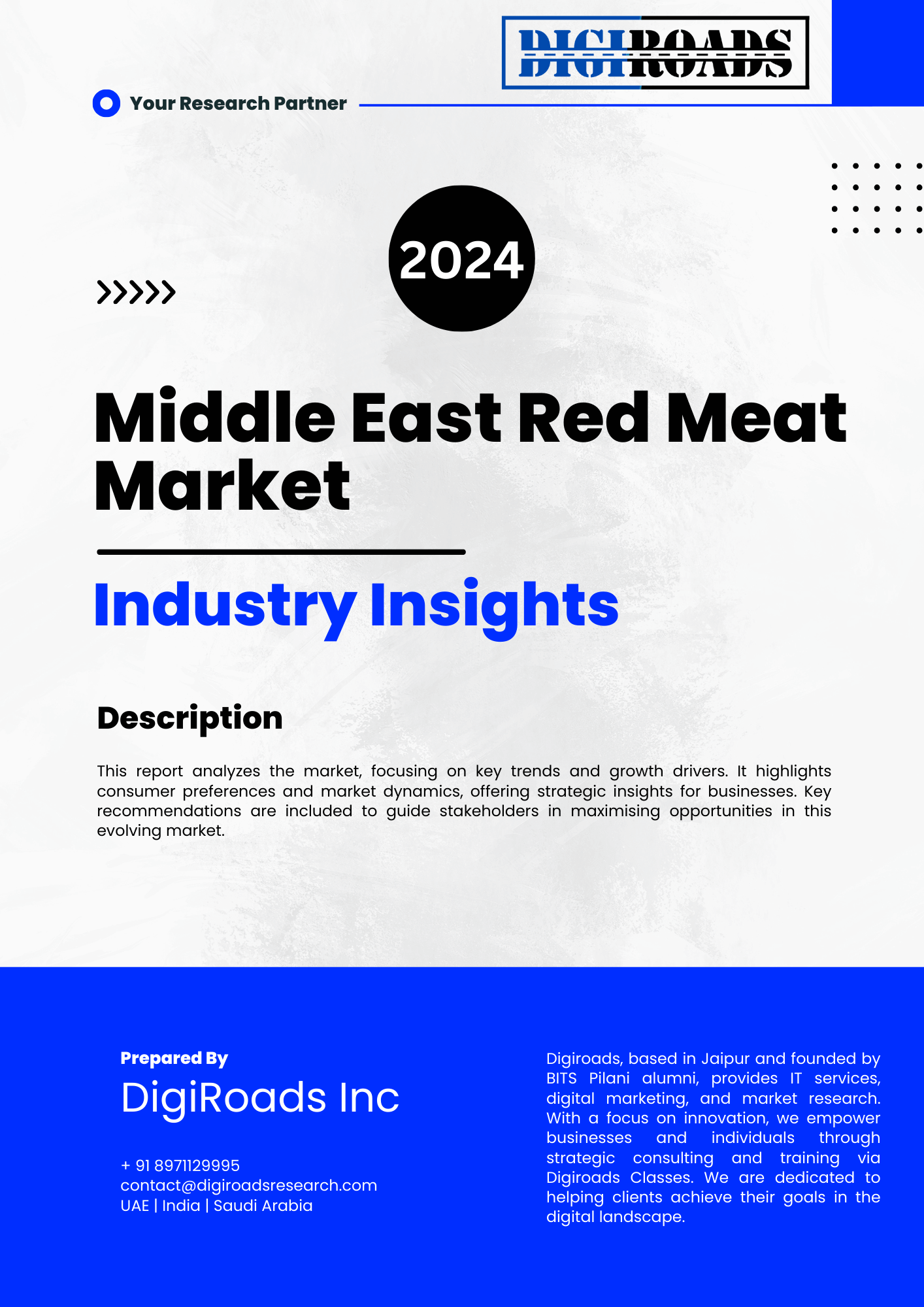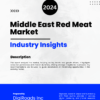Middle East Red Meat Market
- Brand: DigiRoads
The Middle East Red Meat Market report, spanning 120 pages, offers an in-depth analysis of market trends, consumer preferences, and key players. It explores factors influencing demand, including cultural norms, dietary shifts, and economic factors, providing valuable insights for stakeholders.
Middle East Red Meat Market Overview:
The Middle East Red Meat Market size is estimated at 14.11 billion USD in 2024, and is expected to reach 18.5 billion USD by 2034, growing at a CAGR of 3% during the forecast period (2023-2024).
Influenced by evolving consumer preferences and cultural factors, the market encompasses various meat types, including beef, lamb, and veal. Diverse distribution channels, ranging from supermarkets to online platforms, play a pivotal role in reaching consumers. Regional variations, technological advancements, and sustainability considerations contribute to the market’s complexity. Stakeholders navigating this market should prioritize understanding consumer trends, regional nuances, and compliance with regulatory standards. As the industry continues to expand, strategic insights into these dynamics are essential for sustained success.
Middle East Red Meat Market – Report Coverage:
The “Middle East Red Meat Market Report – Forecast (2024-2034)” by Digiroads Consulting, covers an in-depth analysis of the following segments in the Middle East Red Meat Market.
| Attribute | Segment |
| By Type |
|
| By Form |
|
| By Distribution Channel |
|
| By Location |
|
Recent Developments :
Recent developments in the Middle East Red Meat Market highlight a dynamic industry responding to changing consumer demands and global trends. Sustainable sourcing practices have gained prominence, with several key players adopting ethical and environmentally conscious approaches to meat production. Additionally, advancements in technology, such as precision farming and innovative processing methods, are enhancing efficiency and product quality. The rise of e-commerce platforms has transformed distribution channels, providing consumers with convenient access to a diverse range of red meat products. Moreover, ongoing efforts to address health concerns by introducing leaner and healthier red meat options underscore the market’s commitment to meeting evolving consumer preferences. These developments signify a vibrant and adaptive Middle East Red Meat Market, poised for continued growth and innovation.
Middle East Red Meat Market – Dynamics:
Drivers:
Rising disposable income and urbanization: Growing economies and an expanding middle class increase spending on protein sources like red meat. Urbanization leads to busier lifestyles and demand for convenient food options.
Westernization of dietary habits: Exposure to Western cuisines and fast food culture increases red meat consumption, particularly among younger generations.
Population growth and changing demographics: A rapidly growing population, especially in GCC countries, creates a substantial demand for red meat. Rising birth rates and an aging population with varied consumption patterns contribute to market growth.
Government initiatives and self-sufficiency goals: Several countries, like Saudi Arabia, aim to reduce dependence on imports and boost domestic red meat production through infrastructure investments and subsidy programs.
Opportunities:
Expanding e-commerce and online meat delivery: Online platforms offer easier access to red meat across diverse regions, particularly in remote areas.
Product diversification and value-added options: Introducing ready-to-cook marinated meats, frozen portions, and convenience products caters to changing consumer preferences and busy lifestyles.
Focus on halal certification and Islamic slaughtering practices: Meeting religious requirements for meat consumption strengthens market reach and consumer trust.
Investing in cold chain logistics and infrastructure: Improving meat handling and storage facilities minimizes spoilage and ensures product quality, especially in hot climates.
Promoting sustainability and eco-friendly practices: Sustainable livestock farming and minimizing environmental impact through reduced water usage and waste management can attract environmentally conscious consumers.
Restraints:
High reliance on imports: Most Middle Eastern countries depend heavily on imported red meat, making them vulnerable to price fluctuations and supply chain disruptions.
Limited domestic production capacity: Despite government initiatives, domestic red meat production faces challenges like arid climate, limited availability of water and grazing land, and high production costs.
Rising meat prices and inflation: Fluctuations in global meat prices and inflationary pressures can impact affordability and consumer demand for red meat.
Health concerns and changing consumer preferences: Growing awareness of health risks associated with red meat consumption, particularly obesity and cardiovascular disease, could lead to shifts towards alternative protein sources.
Religious restrictions and fasting periods: Religious guidelines on meat consumption during Ramadan and other holy periods can temporarily affect market demand.
Challenges:
Maintaining product quality and freshness: Hot climates and long transportation distances necessitate efficient cold chain infrastructure and effective packaging solutions to prevent spoilage and ensure product safety.
Addressing consumer concerns about sustainability and animal welfare: Implementing ethically sourced meat and sustainable farming practices can address consumer concerns and enhance brand reputation.
Competition from alternative protein sources: The rise of plant-based meat alternatives and cultured meat poses a growing challenge to the traditional red meat market.
Adapting to evolving consumer preferences: Keeping up with changing consumer demands for healthier, more convenient, and ethically sourced red meat products requires constant innovation and market research.
Managing regulatory requirements and trade barriers: Complex import regulations and trade barriers between countries can hinder market expansion and efficient supply chains.
Key Market Players:
Product/Service launches, approvals, patents and events, acquisitions, partnerships and collaborations are key strategies adopted by players in the Middle East Red Meat Market . The top 10 companies in this industry are listed below:
- Almunajem Foods
- BRF S.A.
- Golden Gate Meat Company
- JBS SA
- Kibsons International LLC
- Tanmiah Food Company
- The Organic Meat Company Ltd
- The Savola Group
Key Benefits For Stakeholders:
Strategic Analysis: Gain a comprehensive analysis of the Middle East Red Meat Market to make informed decisions.
Market Expansion: Identify growth opportunities and potential entry points into the market.
Competitive Edge: Stay at the forefront by understanding key players and their strategies.
Consumer Trends Guidance: Stay continuously informed about the evolving preferences and behaviors of consumers in the beef market.
Regulatory Compliance: Navigate the market with a precise understanding of legal frameworks and compliance requirements.
فرص الاستثمار: احدد المجالات المحتملة للاستثمار والتعاون في سوق لحوم البقر المتطورة في الشرق الأوسط.
We have studied the Middle East Red Meat Market in 360 degrees via. both primary & secondary research methodologies. This helped us in building an understanding of the current market dynamics, supply-demand gap, pricing trends, product preferences, consumer patterns & so on. The findings were further validated through primary research with industry experts & opinion leaders across countries. The data is further compiled & validated through various market estimation & data validation methodologies. Further, we also have our in-house data forecasting model to predict market growth up to 2034.
Contact us for any inquiry.
Table of Contents
- INTRODUCTION
1.1 Study Assumptions & Market Definition
1.2 Scope of the Study
- RESEARCH METHODOLOGY
- EXECUTIVE SUMMARY
- MARKET DYNAMICS
4.1 Market Overview
4.2 Market Drivers
4.3 Market Restraints
4.4 Porter’s Five Forces Analysis
4.4.1 Bargaining Power of Suppliers
4.4.2 Bargaining Power of Buyers
4.4.3 Threat of New Entrants
4.4.4 Threat of Substitute Products
4.4.5 Intensity of Competitive Rivalry
- MARKET SEGMENTATION
- Middle East Red Meat Market – By Type of Meat
- Middle East Red Meat Market –By Form
- Middle East Red Meat Market – By Distribution Channel
- By Location
- COMPETITIVE LANDSCAPE
6.1 Most Adopted Strategies
6.2 Market Share Analysis
6.3 Company Profiles
- Brighter Foods Ltd. (The Hut Group)
- The Kellogg Company
- General Mills, Inc.
- Kind LLC
- McKee Foods Corporation
- The Simply Good Foods Company (Atkins Nutritionals, Inc.)
- Clif Bar & Company
- NuGo Nutrition
- Probar LLC
- Premier Nutrition Company, LLC
- MARKET OPPORTUNITIES AND FUTURE TRENDS


